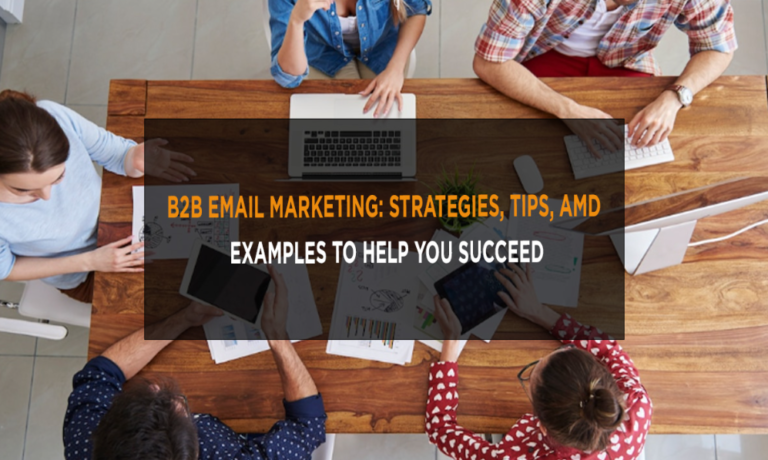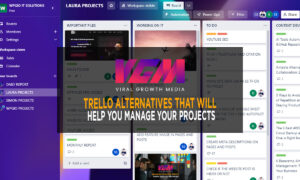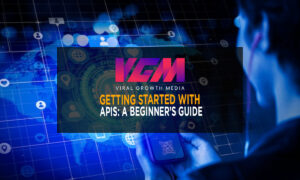Email marketing is one of the most effective ways to reach out to B2B customers. It allows you to build relationships with potential and current customers, and can help you boost your sales and conversions. In this blog post, we will discuss some of the best email marketing strategies for B2B businesses. We’ll also provide some tips on how to create successful emails, as well as a few examples that you can use as inspiration. Let’s get started!
When it comes to B2B email marketing, the key is to focus on quality over quantity. You want to make sure that each and every email you send is relevant and valuable to your recipients. This means segmenting your list so that you’re only sending emails to those who will actually be interested in what you have to say. It also means personalising your messages as much as possible, and making sure that your content is well-written and engaging.
Another important thing to keep in mind is that BtB email marketing requires a different approach than BtC email marketing. BtB customers are typically more busy and have less time to read through long emails. As such, you’ll need to make sure that your emails are short, sweet, and to the point. You should also include a strong call to action so that your recipients know what you want them to do next.
If you’re not sure where to start, don’t worry. We’ve put together a few BtB email marketing examples that you can use for inspiration. Just remember to customise them to fit your own business and audience.
Example 1: The “Thank You” Email
One of the best ways to show your appreciation is by sending a “thank you” email after someone makes a purchase from your company. This is a great opportunity to upsell or cross-sell additional products and services that they might be interested in. Plus, it helps create a sense of loyalty and goodwill between you and your customers.
Example 2: The “We Miss You” Email
If a customer hasn’t interacted with your brand in a while, it’s a good idea to reach out and try to reengage them. This is often referred to as a “win-back” or “reactivation” email. In these messages, you’ll want to highlight the value of your products or services, and offer some sort of incentive (such as a discount) to encourage them to come back.
Example 3: The “Product Announcement” Email
If you’ve got a new product or service that you’re excited about, let your BtB customers know! This is a great way to generate interest and build hype before you launch. In your email, be sure to include all the relevant details (such as pricing, features, etc.) so that your recipients can make an informed decision.
We hope these BtB email marketing examples have inspired you to start crafting your own messages. Just remember to keep our tips in mind, and always test and optimize your emails for the best results. Good luck!
I’d been working in email marketing for a long time before I began my first B2B project. Of course, I knew that B2B campaigns needed to be handled differently than consumer outreach, and I thought I’d made the necessary adjustments.
If you’re a novice learning the ropes or an experienced B2C marketer making the switch, attempting to use anything other than a purpose-built B2B email marketing approach is like playing with fire. I learnt from my mistake and have put up a guide on How to Create a Tailored B2B Email Marketing Campaign in an Effort to Avoid Similar Mistakes.

What is B2B email marketing and why should you care?
BtoB email marketing is a form of direct marketing that uses electronic mail as a means of communicating commercial or fundraising messages to an audience. In its broadest sense, every email sent to a potential or current customer could be considered BtoB email marketing.
However, the term is usually used to refer to more specific types of BtoB messages, such as:
– Prospecting emails sent to customers who don’t buy from you yet
– Engagement emails sent to keep customers interested in your product or service
– Announcement emails about changes or new products/services
– Contest or promotional emails designed to increase customer loyalty
– Reactivation emails sent to lapsed or inactive customers
– Customer satisfaction survey emails
– BtoB email marketing can be a very effective way to reach out to potential and current customers. It allows you to send highly personalized messages, and can be a very cost-effective way to stay in touch with your audience. When done correctly, BtoB email marketing can be an excellent way to build relationships, increase sales, and improve customer loyalty.

The different types of B2B email campaigns
There are different types of B-to-B email campaigns, each with their own set of strategies, tips, and examples.
Here’s a quick rundown of the most popular B-to-B email campaigns:
Prospecting Email Campaigns:
These B-to-B email campaigns focus on building relationships with potential customers who don’t yet know your product or service.
Engagement Email Campaigns:
Once you’ve built a relationship with a potential customer, the next step is to engage them with your product or service. These B-to-B email campaigns are designed to do just that.
Reactivation Email Campaigns:
If a potential customer has shown interest in your product or service but hasn’t taken the next step, a reactivation email campaign can be a great way to get them back on track.
Retention Email Campaigns:
Once you’ve got a customer, you want to keep them. These B-to-B email campaigns are designed to do just that.
Upsell/Cross-Sell Email Campaigns:
If you’ve got a customer who’s happy with your product or service, these B-to-B email campaigns can help you sell them more.
No matter what type of B-to-B email campaign you’re looking to run, there are certain strategies, tips, and examples that can help you succeed. Here are a few of the most important:
Make sure your B-to-B email list is up to date and accurate:
There’s no point in sending emails to people who will never see them.
Personalize your B-to-B emails as much as possible:
Generic messages are less likely to be opened and read.
Keep your B-to-B email messages short and to the point:
People are busy and they don’t have time to read long, drawn-out emails.
Make sure your B-to-B email calls to action are clear and concise:
You want people to know exactly what you want them to do.
How to create a successful email campaign strategy
When it comes to BtoB email marketing, the most important thing you can do is to create a successful email campaign strategy.
Here are some tips on how to do just that:
-Think about your audience and what would resonate with them. What kind of information would they find valuable?
-Create content that is not only informative but also visually appealing.
-Make sure your subject lines are clear and to the point.
-Test, test, and test again! Try different tactics and see what works best for your audience.
Tips for improving your open and click-through rates
When it comes to B-to-B email marketing, there are a few key things you can do to improve your open and click-through rates. First, make sure your subject lines are clear, concise, and interesting. Second, personalize your emails as much as possible. And third, focus on providing value to your recipients.
Here are a few specific tips to keep in mind:
– Keep your subject lines short and to the point.
The average person only spends a few seconds looking at an email before deciding whether or not to open it, so you need to make sure your subject line is compelling enough to get them to take that first step.
– Personalise your emails as much as possible.
B-to-B email marketing is all about building relationships, so the more you can personalise your messages, the better. Include the recipient’s name in the subject line and body of the email, and make sure to address them by name when you can.
– Focus on providing value.
B-to-B email marketing is not about selling, it’s about providing value to your recipients. Make sure the content of your emails is helpful, informative, and relevant to their needs.
Examples of effective B2B email marketing campaigns
B2B email marketing can be a great way to reach out to potential and existing customers. However, it’s important to make sure that your campaigns are effective in order to get the most out of them.
Here are some examples of successful B2B email marketing campaigns:
-The first example is from Salesforce, who used B2B email marketing to increase their customer base by 15%. They did this by sending out a series of B2B email campaigns that offered customers free trials, discounts, and other incentives.
-Another great example is from HubSpot, who used B2B email marketing to increase their website traffic by 50%. They did this by sending out a series of B2B email campaigns that offered customers free trials, discounts, and other incentives.
As you can see, B2B email marketing can be a very effective way to reach out to potential and existing customers. However, it’s important to make sure that your campaigns are well-thought-out and offer something of value to the customer. If you do this, you’ll be sure to see success with your B B email marketing efforts.
Strategies for getting the most out of your email marketing campaigns
As a B to B marketer, email should be one of your go-to tools for reaching out to potential and current customers. But with so many options and strategies available, it can be tough to know where to start.
Here are some tips and examples for how you can use email marketing successfully in your B to B business.
– Use segmentation to target your audience:
One of the great things about email marketing is that you can segment your list to send targeted messages to specific groups of people. This could be based on factors like their location, job title, or even what stage they are in the buyer’s journey.
– Personalise your emails:
Personalization is key in any marketing campaign, but it’s especially important in email. Adding a person’s name to the subject line or body of an email can make a big difference in whether or not they open it.
– Keep your messages short and to the point:
B to B buyers are busy people, so they appreciate emails that get straight to the point. Long, rambling messages are more likely to be ignored.
– Use a strong call to action:
Every email you send should have a clear call to action, whether it’s asking people to click through to your website or sign up for a free trial. Without a CTA, your emails are likely to fall flat.
By following these tips, you can create email campaigns that will engage and convert your B to B audience. So what are you waiting for? Get started today!

Tips for creating high-quality content that will engage your audience
When creating B-to-B email marketing content, it’s important to keep your audience in mind. What are their needs and wants? What sort of information would be most useful or interesting to them? Write your content with these things in mind, and you’ll be well on your way to creating material that will engage and resonate with your B-to-B contacts.
Here are a few additional tips to keep in mind when crafting B-to-B email marketing content:
– Make sure your content is well researched and accurate:
Nothing will lose your audience’s trust faster than inaccurate information.
– Write in a clear, concise style:
B-to-B audiences are often busy professionals with limited time to spare. Get to the point and make your points clearly.
– Use strong calls to action:
B-to-B email marketing is all about driving conversions, so make sure your content includes strong calls to action that incentivize your contacts to take the next step.
Examples of B2B email marketing campaigns that have been successful
– A campaign from HubSpot that offered a free e-book on B-to-B email marketing best practices
– A campaign from Salesforce that offered a free webinar on B-to-B lead generation strategies
Both of these campaigns offered valuable, relevant content that was targeted at the needs of their B-to-B audiences. They also included strong calls to action that encouraged their contacts to take advantage of the resources being offered.
Wrap-up and final thoughts
Email marketing can be a powerful tool for B-to-B companies. By following some best practices and using the right strategies, you can create successful B-to-B email marketing campaigns that will help you achieve your business goals.

When planning your B-to-B email marketing strategy, keep in mind the following tips:
– Keep your audience and their needs in mind:
Before you start crafting your BtoB email marketing strategy, it’s important to keep your audience and their needs top of mind. What are their pain points? What solutions are they looking for? Once you have a good understanding of your target market, you can start thinking about how to best reach them through email.
-Segment your list to create targeted campaigns
Email is a powerful tool for B²B marketers. But it’s not always easy to get right. Follow the strategies, tips, and examples in this post to create B²B email marketing campaigns that will help you succeed.
-Segment your list to create targeted campaigns
The first step to successful B²B email marketing is segmenting your list. By dividing your contacts into smaller groups, you can create more targeted and relevant campaigns. This ensures that your recipients are more likely to engage with your emails.
There are a number of ways to segment your list. You can segment by:
– geographic location
– job title
– company size
– industry
– buying stage
Once you’ve segmented your list, you can start creating targeted campaigns. personalize your subject lines and content
B²B buyers are bombarded with emails every day. To stand out from the crowd, you need to personalize your subject lines and content. This means including the recipient’s name, company, or other relevant information in your email.

Why B2B emails require B2B strategies
Because you’re attempting to attract a variety of individuals through the door, B2B email marketing techniques don’t function in the same way as two nearly identical doors necessitate different keys. Here are a couple of examples of how general email marketing approaches fall short when used on B2B campaigns.
Email targeting
B2B email marketing, on the other hand, focuses on businesses—often referred to as a group of people. A person who receives a B2C email is solely responsible for each stage of their purchase journey, but a company’s purchasing process involves many individuals in various roles.
When you look for a B2B target, you’re really seeking for an organization of individuals—and your approach must take these variations into account.
Cycle length
It only takes a few minutes to shop for things on your own. I’ll borrow one of my favorite Ariana Grande songs: you see it, you like it, you want it, and you’ve got it.
6 key strategies for designing a B2B email campaign
You’ve probably concluded by now that B2C and general email marketing are not an option for your B2B campaign. However, simply informing you what methods to avoid without offering alternatives isn’t particularly useful, is it? Here’s how to create a successful B2B email marketing campaign.
1. Profile your target customers
When you’re advertising to a certain B2B company, you’re really targeting the company’s buying center, which is made up of six key positions.
Initiators
The first people to discover and be enthusiastic about your product are the ones who will spread the word.
Users
The people who will be using your product on a regular basis after the purchase are known as early adopters.
Buyers
The people who run the logistics and administrative aspects of a prospective purchase, such as budgeting, contract terms, renewals, etc., are referred to as brokers.
Deciders
It’s the people who decide whether or not to let a buyer go ahead with a deal.
Gatekeepers
Controllers are the individuals (usually executives) who control the exchange of information between other members of the buying center.
Influencers
The ultimate decision-making body, this category includes all people who have influence on the decisions and opinions of other members of the purchasing center. (In other words: anybody else in the organization.
2. Think like a buyer
With a customer profile matrix in hand, you may enter the mentality of each member of your target consumer’s buying center to better understand which emails would be appropriate for each role. An Initiator, for example, or a User might be interested in receiving a how-to guide that relates to their job function. If you sent the same email to a buyer who primarily deals with purchasing and renewal of a product rather than its real purpose, it would almost certainly be deleted.
3. Use email segmentation
The concept of personalizing my emails to each person at a firm makes me want to run for the hills when I’m running campaigns on a large scale.

4. Plan your campaign in stages
The B2B email marketing cycle should follow the same pattern as the B2B customer journey. You may tailor your campaign to each stage of the consumer journey by planning it around the stages of the customer journey. There are five distinct phases in a buyer’s journey, and certain forms of material work best at each one.
Awareness:
The objective is to get the prospect familiar with your business and product, but he or she hasn’t made a decision yet. How-to guides, eBooks, thought leadership, and other instructional material may assist the target in becoming more acquainted with your company.
Consideration:
The aim is particularly interested in your product, but they won’t get to the decision-making stage until they’ve had more information. Case studies, customer testimonials, and product demonstrations can all provide valuable information about the value of your product and encourage the target to make a purchase.
Decision-making:
The customer has expressed an interest in purchasing or trying your product, and they are now considering things like budget and return on investment to see whether they’re ready to buy. Free trials, low-cost offers, and cost estimates may sway your target toward a purchase.
Retention:
When you’ve convinced a prospect to become a customer, the objective is for them to make a purchase, renew their subscription, or otherwise maintain their client relationship. Product tutorials and high-level instructional content can assist your target in getting the most out of your product’s capabilities and maintaining a customer.
Advocacy:
Loyal consumers can assist your marketing efforts by becoming brand advocates—they’ll tell others about your product and bring in new targets. Customers may be more engaged in active brand advocacy through surveys and referral program incentives.

5. Use templates
Another essential tool in your work-smarter-not-so-harder toolbox is email templates. Creating a strong collection of excellent templates takes time, but you’ll thank yourself later when you’re able to zip through hundreds of emails every day and still clock out by five.
Templates are useful for making sending emails simpler because they avoid you from having to write the same text over and over again. The key to utilizing templates is to keep the email recipient ignorant of their origin. Make a collection of templates for each distinct sort of communication that you send, using the same brand components across the board, but ensuring that each template is visually unique.
- Thank-you emails
- Gated content delivery emails
- Survey emails
- Curated content roundup emails
- Newsletter and what’s new emails
- Educational and thought leadership emails
- Case study and report emails
- Event and webinar emails
- Unsubscribe emails
When you create a template library, it’ll not only make your life easier, but it’ll also guarantee that you can take vacation while knowing that someone else will be able to finish what you’ve started.
6. Save time by automating
You’ll be able to complete time-consuming details with automated email marketing.
You could, for example, create an automation that tags email contacts with any new information about them, such as demographic data and job requirements. With a flexible tagging strategy in place, you may target hyper-specific audiences like “female executives in the biotech industry” or “people who attended events in the Los Angeles region” with only a few sort criteria.
Best practices for B2B emails
You might devise the finest B2B email strategy the world has ever seen, but it won’t accomplish much if the content inside isn’t up to snuff. The quality of packaging and structural integrity are crucial to a successful burrito, but everyone knows what makes it great is what’s inside.
Write great subject lines
In fact, this advice applies to all types of email marketing. All email marketers should be verifying that their subject lines are long enough to display in the inbox. B2C emails, on the other hand, have a far greater chance of succeeding despite an ineffective subject line.The way alcohol delivery apps write their subject lines irritates me, but I open all of their emails since I like being able to purchase wine without putting on shoes. But when I’m at work? A cold email with an annoying topic will be immediately routed to spam.
The takeaway is that the more crowded your targets are, the more crucial your subject lines will be. Place your email’s added value (the resource, tool, or offer it contains) at the top of the line (preferably in larger type than everything else). Make your call-to-action as obvious as possible— inform them right away what you want them to read, watch, submit, or sign up for.
Personalise as much as humanly (or automatically) possible:
I previously said how crucial it is to automate certain campaign activities, such as email segmentation and audience targeting. You may use import fields in the email itself to make sure the message is addressed to your recipient by name, include their company in the subject line, and add other information that makes your email appear less blanket.
Custom fields are more essential for B2B emails than consumer blasts, and in terms of subject lines, they’re even more significant. The majority of the emails from that alcohol delivery service feature a single large image with a coupon or deal—it isn’t personalized to me because it doesn’t have to be.
Be conversational:
It’s easy to go into business mode and come off as cold and robotic when writing B2B content. Keep in mind that you’re addressing individuals, not just businesses.

Keep things scannable:
If you think about it, the most effective emails are generally quite brief. Businesspeople have a lot on their plates, and few people have the patience to read through an email full of text.
Keeping your emails short doesn’t imply you can’t provide them substance. You may include a lot of information in an email using effective formatting and a little bit of strategic design. Furthermore, the objective is to get people to click on your material, so it’s fine to place the excellent stuff after the jump.
Conclusion
Email marketing is a powerful tool for B2B businesses. It allows you to build relationships with potential and current customers, and can help you boost your sales and conversions. In this blog post, we have provided some of the best email marketing strategies for B2B businesses. We’ve also provided tips on how to create successful emails, as well as examples that you can use as inspiration. If you want to learn more about email marketing or need help getting started, contact us today. We would be happy to assist you!























